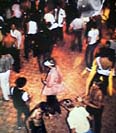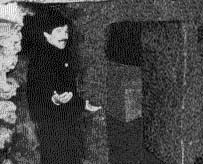
Historical Tales | News | Vampires | Zombies | Werewolves
Virtual Academy | Weapons | Links | Forum
The Vampires of Studio 54
 |
| Cutting the rug at Studio 54 |
One Studio 54 regular was not so quick to dismiss the story: Geraldo Rivera, a brash young reporter for ABC-TV. Rivera was looking to make a name for himself and thought that breaking the vampire story would be a sure way to put him on the map. His sources for the story were a group of disgruntled former Studio 54 employees. All claimed they were fired by Rubell when they refused to keep quiet about the vampires. One Sunday afternoon, former 54 bartender Francisco Birney snuck Rivera through a back entrance into the Studio 54 basement and showed him a mysterious locked vault where he claimed that the vampires slept during the day.
Rivera pitched the story to his superiors at ABC; they were wary and suggested he find an expert who could give the story credibility. Damien Gould fit the bill. Gould was a respected, thirty-year FVZA vet who had fallen on hard times and needed the cash promised by Rivera and ABC.
Rivera talked his bosses into making the crypt-opening a one-hour live special. The show was hyped as the first assault on vampires ever carried on live television, although the location of the assault was kept undisclosed so as not to tip off Rubell and Studio 54 management. The cryptic marketing campaign intrigued the nation, and on the night of September 4, 1977, approximately 40 million Americans sat down in front of their TV sets to watch host David Hartman introduce the special with the words "we're about to do something that has never been done before."
 |
| Rivera prepares to enter the crypt |
 |
| Rivera a day after battling the "vampires" |
In all, five former Studio 54 employees were involved in the hoax. They admitted that they had hatched the scheme in the hopes of bringing bad publicity to Rubell and Studio 54. It was only after they got Rivera involved did they begin to see an opportunity to get what 54 patron Andy Warhol might have called "their 15 minutes of fame."
Studio 54 was eventually brought down, but it was the tax man, not vampires, who did the job. As for Rivera, although his reputation took a hit and he became something of a laughingstock, he survived the embarrassment and continued his career in television. Agent Gould was not so lucky: humiliated, he sank into a pit of drinking and despair and died in a rooming house far from the bright lights of